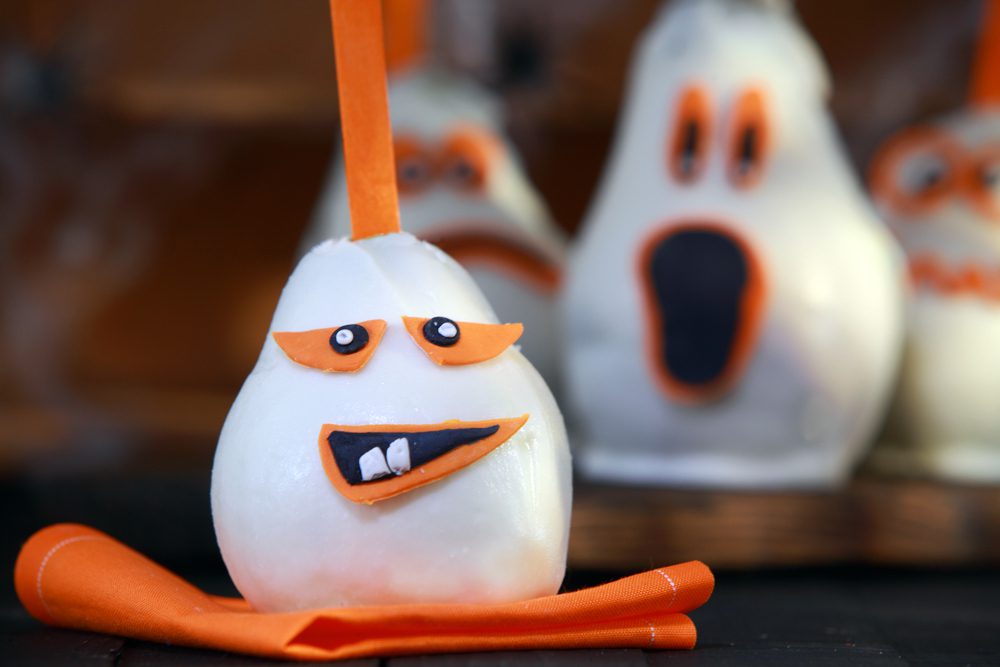It usually begins sometime in August. My youngest child, a member of that category of individual known as Highly Sensitive, gets a glimpse of some Halloween-oriented decoration, and announces his refusal to enter any retail establishment until well after Thanksgiving. (I know, every mom should be so lucky.) Around the same time, he becomes extremely watchful whenever we go anywhere in the car, ready to hide his eyes should an offending billboard or overly horrific house decorations insert themselves into his field of vision. He steadfastly refuses to dress up or go trick-or-treating for Halloween, and when the trick-or-treaters start to come, he hides in another room of the house until it’s all over.
This year has been a little better for him, in part because he’s older and is to some extent beginning to conquer his fear, but also because Halloween doesn’t seem to be as much of a happening in Oklahoma as it was in Illinois. I will never forget our first Halloween in Illinois after moving there some 20 years ago from Texas. I was immediately struck by the enthusiasm with which people embraced Halloween. The decorations were ubiquitous and extensive, sometimes rivaling even the most extravagant Christmas displays. On the witching night itself the trick-or-treaters came fast and furious, and one corner of our Peoria neighborhood turned into a mini block party, with hot apple cider flowing, a fire dancing in the driveway, and marshmallows generously handed out for the roasting. Lawn chairs lined the sidewalk and parents sat and talked while their children covered first one side of the street, then the other.
So We’re Opting Out of Halloween
Maybe if my third child had experienced that sort of Halloween he wouldn’t find it so anathema now. Instead, he grew up in the Chicago suburbs, where Halloween seemed to be less innocuous and a lot gorier than in Peoria. Little by little, my own antipathy for the holiday increased. I don’t know if it was the rising price of candy or the six-foot-tall trick-or-treaters with an entitlement mentality showing up in jeans and t-shirts to grunt while holding open pillowcases, but somewhere along the way I lost the Halloween spirit. I grudgingly bought the candy each year only because my husband insisted on it—he is a much better neighbor than I am—and only because my older children were willing to take over handing it out. On Halloween night I gladly withdrew to the back of my house with my younger son and did my best to ignore the whole ridiculous thing.
So it was a pleasant surprise this year to find out that here in our part of Oklahoma trick-or-treating is a take-it-or-leave-it proposition. It is apparently just as common here to go to a community event as it is to trick or treat. My church, in fact, hosts a “Fall Festival” on Halloween night, and that is where we will be this year. Costumes are optional, and scary ones are not allowed. There will be candy, a jumping house, hay rides, and various carnival games. A little before 6:00 p.m. we will lock up our house, turn off our porch light, and vacate the premises for church. When we get home sometime after 8, it will all be over. A better Halloween celebration I could not have designed myself.
I Tried to Like Halloween, But It Didn’t Take
I don’t like Halloween. But that is just me. I don’t expect the rest of the world to share my hang-ups. I am a Christian, but that is not why I dislike Halloween. I dislike it because of my own issues, and I freely admit that I am a Halloween Grinch. There is nothing wrong with observing Halloween, and I am happy for my friends’ and neighbors’ enjoyment of it. When I was in elementary school I did the Halloween thing, too. I tricked-or-treated twice each year, once for UNICEF and once for candy. I participated in my school’s Halloween carnival, helping to man the fifth grade haunted house for the kids in the lower grades (it was my job, as I sat behind a bowl of peeled grapes, to repeatedly intone in as spooky a voice as a I could muster, “Fe-e-e-el the witch’s e-y-e- b-a-a-allssss”).
I homeschool my children, but if my youngest were in a regular school, I would not be making a stink about Halloween, demanding its eradication to accommodate our sensibilities so our dainty little feelings don’t get hurt. Come Halloween party day, I would simply keep him home (if after trying my best to help him get a grip and just go with the flow he still found the prospect too daunting). The cancellation of school Halloween parties is part and parcel with replacing Christmas parties with vague celebrations of winter that go so far as to forbid the wearing of red and green. Seriously? How about maroon and teal? Would those survive inspection by the Color Police?
News flash: school is 180 days of doing the same thing, with little variation, over and over and over. Good teachers love any excuse to shake things up so their classroom doesn’t resemble a greenhouse full of potted plants by Columbus Day. In a school setting, Halloween, Thanksgiving, Christmas, Hanukkah, Valentine’s Day, Easter, and the like are less about observing whatever the holiday represents than they are about breaking up the soul-sucking monotony of sitting in the same desk, in the same room, listening to the same person, for upwards of 1,000 hours. Let kids—and their teachers—have Halloween, and all the rest of it. Just give time for conscientious objectors to selectively self-exclude. And if you really want to cancel a holiday, quit wasting time and energy on Halloween and go after something truly offensive, like Earth Day. Now there’s a celebration worth outlawing.



